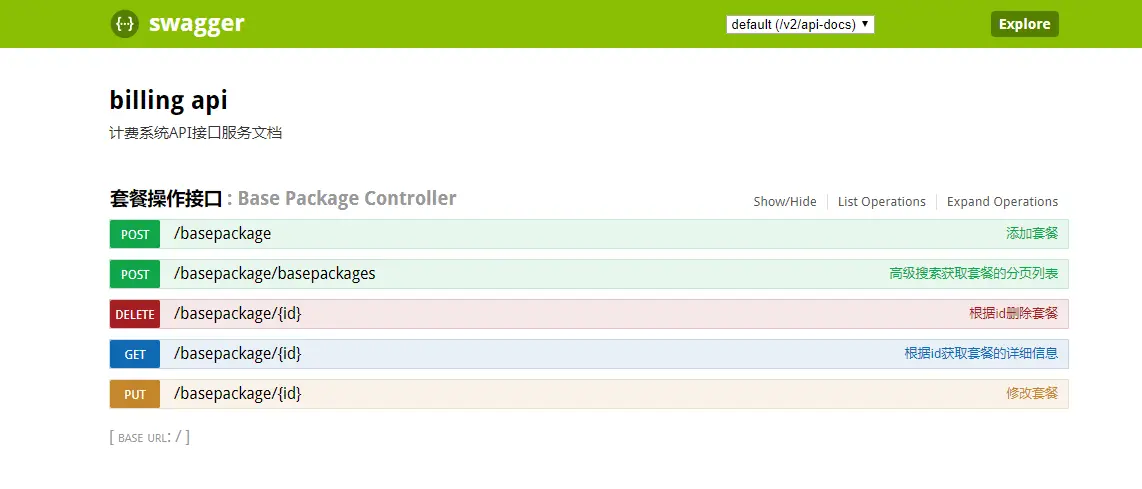先展示一下效果图

配置流程:
1.添加依赖:
<!-- Swagger -->
<dependency>
<groupId>io.springfox</groupId>
<artifactId>springfox-swagger2</artifactId>
<version>2.6.1</version>
</dependency>
<dependency>
<groupId>io.springfox</groupId>
<artifactId>springfox-swagger-ui</artifactId>
<version>2.6.1</version>
</dependency>2.swagger配置:
package com.ligowave.bill.common.config;
import org.springframework.context.annotation.Bean;
import org.springframework.context.annotation.Configuration;
import springfox.documentation.builders.ApiInfoBuilder;
import springfox.documentation.builders.PathSelectors;
import springfox.documentation.builders.RequestHandlerSelectors;
import springfox.documentation.service.ApiInfo;
import springfox.documentation.spi.DocumentationType;
import springfox.documentation.spring.web.plugins.Docket;
@Configuration
public class SwaggerConfig {
@Bean
public Docket createRestApi(){
return new Docket(DocumentationType.SWAGGER_2)
.apiInfo(apiInfo())
.select()
// Swagger会扫描该包下所有Controller定义的API,并产生文档内容(除了被@ApiIgnore注解的API)
.apis(RequestHandlerSelectors.basePackage("com.ligowave.bill.web"))
// 可以根据url路径设置哪些请求加入文档,忽略哪些请求
.paths(PathSelectors.any())
.build();
}
private ApiInfo apiInfo(){
return new ApiInfoBuilder()
// 页面标题
.title("billing api")
// 描述
.description("计费系统API接口服务文档")
.build();
}
}
3.启动类上添加@EnableSwagger2表示开启swagger注解
package com.ligowave;
import org.springframework.boot.SpringApplication;
import org.springframework.boot.autoconfigure.SpringBootApplication;
import springfox.documentation.swagger2.annotations.EnableSwagger2;
@SpringBootApplication
@EnableSwagger2
public class ApiServiceBillingApplication {
public static void main(String[] args) {
SpringApplication.run(ApiServiceBillingApplication.class, args);
}
}
4、restful接口:
package com.ligowave.bill.web;
import com.ligowave.bill.common.bean.Response;
import com.ligowave.bill.common.bean.ResponseCode;
import com.ligowave.bill.common.bean.ResponseMsg;
import com.ligowave.bill.common.bean.User;
import com.ligowave.bill.domain.billsystem.entity.BasePackage;
import com.ligowave.bill.domain.billsystem.vo.BasePackageEdit;
import com.ligowave.bill.domain.billsystem.vo.BasePackageQuery;
import com.ligowave.bill.domain.billsystem.vo.BasePackageSave;
import com.ligowave.bill.service.BasePackageService;
import com.ligowave.bill.web.base.BaseController;
import io.swagger.annotations.*;
import org.apache.commons.lang3.StringUtils;
import org.springframework.beans.factory.annotation.Autowired;
import org.springframework.data.domain.Page;
import org.springframework.http.MediaType;
import org.springframework.web.bind.annotation.*;
import javax.servlet.http.HttpServletRequest;
import java.util.List;
@Api(value = "BasePackageController", tags = {"套餐操作接口"})
@RestController
public class BasePackageController extends BaseController {
@Autowired
BasePackageService basePackageService;
/**
* 获取套餐的分页列表
*/
@ApiOperation(value = "高级搜索获取套餐的分页列表")
@ApiImplicitParam(name = "basePackageQuery", value = "套餐列表查询条件对象", required = true, dataType = "BasePackageQuery")
@RequestMapping(value = "/basepackage/basepackages", method = {RequestMethod.POST}, produces = MediaType.APPLICATION_JSON_VALUE)
public Page<BasePackage> pageList(@RequestBody BasePackageQuery basePackageQuery) {
return basePackageService.findPageList(basePackageQuery);
}
/**
* 根据id获取套餐的详细信息
*/
@ApiOperation(value = "根据id获取套餐的详细信息")
@ApiImplicitParam(name = "id", value = "套餐ID", required = true, dataType = "Integer",paramType = "path")
@RequestMapping(value = "/basepackage/{id}", method = RequestMethod.GET)
public Response<BasePackage> getById(@PathVariable(value = "id") Integer id) {
BasePackage basePackage = basePackageService.getById(id);
if (null != basePackage) {
return new Response<>(ResponseCode.SUCCESS, ResponseMsg.SUCCESS, basePackage);
} else {
return new Response<>(ResponseCode.UNKNOWN_ERROR, ResponseMsg.UNKNOWN_ERROR, null);
}
}
/**
* 修改套餐
*/
@ApiOperation(value = "更新套餐信息",notes="根据url的id来指定更新对象,并根据传过来的basePackageEdit信息来更新套餐详细信息")
@ApiImplicitParams({
@ApiImplicitParam(name = "id", value = "用户ID", required = true, dataType = "Long",paramType = "path"),
@ApiImplicitParam(name = "basePackageEdit", value = "套餐详细实体", required = true, dataType = "BasePackageEdit")
})
@RequestMapping(value = "/basepackage/{id}", method = RequestMethod.PUT)
public Response<BasePackage> update(@PathVariable(value = "id") Integer id,
@RequestBody BasePackageEdit basePackageEdit) {
BasePackage basePackage = basePackageService.update(id, basePackageEdit);
return new Response<>(ResponseCode.SUCCESS, ResponseMsg.SUCCESS, basePackage);
}
/**
* 根据id删除套餐
*/
@ApiOperation(value = "删除套餐",notes="根据url的id来指定删除对象")
@ApiImplicitParam(name = "id", value = "套餐ID", required = true, dataType = "Integer",paramType = "path")
@RequestMapping(value = "/basepackage/{id}", method = RequestMethod.DELETE)
public Response<BasePackage> deleteById(@PathVariable(value = "id") Integer id) {
try {
basePackageService.deleteByID(id);
} catch (Exception e) {
e.printStackTrace();
return new Response<>(ResponseCode.UNKNOWN_ERROR, ResponseMsg.UNKNOWN_ERROR, null);
}
return new Response<>(ResponseCode.SUCCESS, ResponseMsg.SUCCESS, null);
}
/**
* 添加套餐
*/
@ApiOperation(value = "添加套餐")
@ApiImplicitParam(name = "basePackageSave", value = "套餐详细实体", required = true,dataType = "BasePackageSave")
@RequestMapping(value = "/basepackage", method = RequestMethod.POST)
public Response<BasePackage> save(@RequestBody BasePackageSave basePackageSave, HttpServletRequest request) {
User user = getCurrentEmployee(request);
//校验套餐名称、下架时间、最大出账周期、套餐价格不能为空
if (StringUtils.isBlank(basePackageSave.getName()) || StringUtils.isBlank(basePackageSave.getEndTimeStr()) || basePackageSave.getMaximumAccount() == null ||
basePackageSave.getPackagePrice() == null) {
return new Response<>(ResponseCode.PACKAGE_PARAM_ERROR, ResponseMsg.PACKAGE_PARAM_ERROR, null);
}
//校验套餐名称是否存在
if (checkNameExist(basePackageSave.getName(), user.getOrgid())) {
return new Response<>(ResponseCode.PACKAGE_EXISTED, ResponseMsg.PACKAGE_EXISTED, null);
}
basePackageService.save(basePackageSave);
return new Response<>(ResponseCode.SUCCESS, ResponseMsg.SUCCESS, null);
}
/**
* 根据套餐名和组织ID验证唯一性
*/
private boolean checkNameExist(String name, String orgId) {
boolean exist = false;
if (!StringUtils.isBlank(name)) {
List<BasePackage> list = basePackageService.findByNameAndOrgId(name, orgId);
if (null != list && list.size() > 0) {
exist = true;
}
}
return exist;
}
}
上述用到的swagger注解有:
@Api()用于类
@ApiOperation()用于方法
@ApiParam()用于方法,参数,字段说明
5.用于接收传入参数的对象:
package com.ligowave.bill.domain.billsystem.vo;
import io.swagger.annotations.ApiModel;
import io.swagger.annotations.ApiModelProperty;
/**
* 套餐列表搜索条件
*/
@ApiModel(description = "套餐列表查询条件")
public class BasePackageQuery extends BaseQuery {
@ApiModelProperty(value = "套餐名称", dataType = "String")
private String name;
@ApiModelProperty(value = "描述", dataType = "String")
private String description;
@ApiModelProperty(value = "是否被引用", dataType = "Integer", notes = "0-是,1-否")
private Integer whetherReferenced;
@ApiModelProperty(value = "发布时间始于", dataType = "String", notes = "格式为:yyyy-MM-dd HH:mm:ss")
private String beforeBegintime;
@ApiModelProperty(value = "发布时间终于", dataType = "String", notes = "格式为:yyyy-MM-dd HH:mm:ss")
private String afterBegintime;
@ApiModelProperty(value = "组织ID", dataType = "String")
private String orgId;
public String getName() {
return name;
}
public void setName(String name) {
this.name = name;
}
public String getDescription() {
return description;
}
public void setDescription(String description) {
this.description = description;
}
public String getBeforeBegintime() {
return beforeBegintime;
}
public void setBeforeBegintime(String beforeBegintime) {
this.beforeBegintime = beforeBegintime;
}
public String getAfterBegintime() {
return afterBegintime;
}
public void setAfterBegintime(String afterBegintime) {
this.afterBegintime = afterBegintime;
}
public Integer getWhetherReferenced() {
return whetherReferenced;
}
public void setWhetherReferenced(int whetherReferenced) {
this.whetherReferenced = whetherReferenced;
}
public String getOrgId() {
return orgId;
}
public void setOrgId(String orgId) {
this.orgId = orgId;
}
}
效果图展示:

上述用到的注解:
- @ApiModel:用对象来接收参数
- @ApiModelProperty()用于方法,字段; 表示对model属性的说明或者数据操作更改
6.swagger默认访问地址为:http://localhost:8080/swagger-ui.html